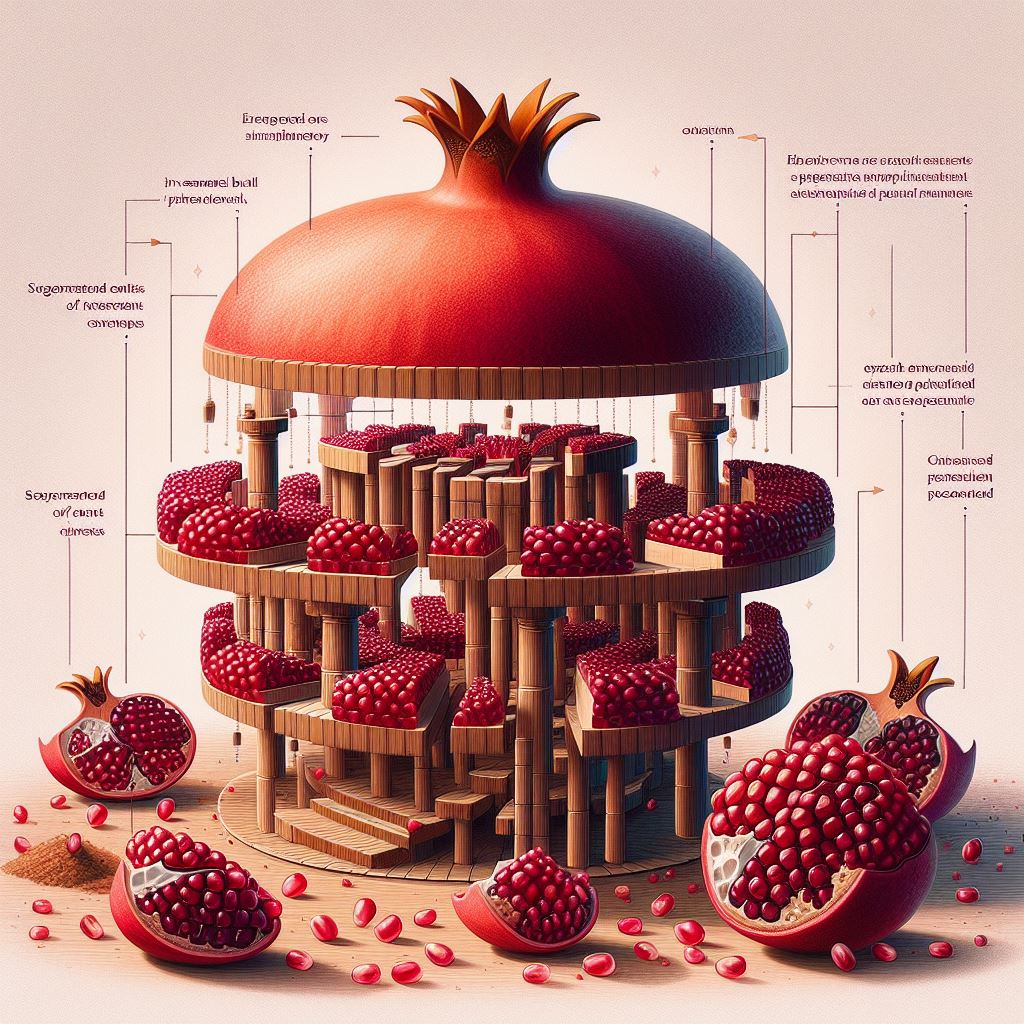Are you interested in learning about investment basics from pomegranates?
Fundamentals of investment can be discovered in the most unexpected places, even in nature. Today, we'll journey into investments, drawing parallels and insights from the humble pomegranate. While these concepts may appear straightforward, nature's patterns can reveal hidden algorithms that can be applied across various fields, including investing.
First, let's take a moment to appreciate the structure of a pomegranate. The fruit encasing the seeds is a marvel of nature. It can be seen as a terrain of consciousness, where seeds of varying colors represent unique natural ambitions. For instance, red might symbolize the fiery drive to succeed, undeterred by challenges or adversity.
We encounter a scientific notion that atomic explosions cause discord and force unified entities to segregate. However, if we observe the growth of pomegranate seeds, we might arrive at a different perspective. Despite the illusion of separation, the seeds are bonded, culminating in a flavorful fruit. This fruit can be analogized to a cluster of segregated entities that, when joined together, form a solid investment entity.
Think of the pomegranate seeds as entities. When entities of similar nature are bonded together, they form an attractive, risk-free fruit for investors to consume. Why risk-free? Because the fruit naturally grows more potent as it's consumed, mirroring the strengthening of an investment as it matures.
Let's delve into the science of bonding entities. The angle of the presidency can be seen as a metaphor for the complex charges within a specific diaspora of basic investment principles. Each layer of the pomegranate is a testament to nature's prudence, which can be likened to self-sustained investment.
Like a pomegranate with the same color grouped, the quality of the seeds, whether sour or sweet, must be identified. This doesn't imply differentiating between sour and sweet but understanding the depth of knowledge. Like investments, life is only sometimes favorable, and only some ventures yield positive returns.
Let's explore the science of algorithmic trading, which is ingeniously hidden within the pomegranate's structure. When a secondary market deviates from its path, the resultant chaos can be systematically understood through the layers of a pomegranate. When the pendulum causes a loss of surroundings, the cluster moves to the center, much like market trends.
A market that gravitates in one direction due to the influence of the participants—similar to the centered nature of a pomegranate—will eventually center around the participants. This can be seen as entities with similar pattern grouping, forming a pattern through formulas and judgments. The centered market participants adjust according to economic parameters when markets face uncertainty.
Imagine we have 1000 seeds, each representing a different organizational entity structure. The portion of the calculated algorithm is similar to each seed's distance from the centralized algorithm variable. The nutritional value of a pomegranate is akin to the sector-specific value of an investment cycle within a particular group of seeds.
Nature teaches us that when we carefully group specific industries - similar to the nutritional value of a pomegranate - that group will yield consistent profitability that can be standardized to universal parameters. Investors can consume this standardized value to generate standardized profits unaffected by the entry or exit of other market participants.
In conclusion, nature, specifically pomegranates, can teach us much about investment basics. Observing the layers and bonding of pomegranate seeds gives us a deeper understanding of investments and algorithmic trading. Furthermore, by grouping entity seeds and understanding sector-specific value in investment cycles, we can make informed investment decisions leading to profitable and standardized results.
But let's not stop there; the world of pomegranates and investments is vast, and there is much more to explore.
In their natural cycle, pomegranates go through stages of growth, maturity, and eventual decay, much like the financial markets. The budding fruit represents the initial investment phase, full of potential but not yet realized. As the fruit matures, the seeds multiply, symbolizing the growth and maturity of an investment.
Just as a pomegranate needs the right conditions to flourish, investments also need favorable conditions. Understanding these conditions can help an investor make the right decisions at the right time.
The eventual decay of the fruit can be likened to the depreciation of an investment. This doesn't necessarily mean failure but is a natural part of the investment life cycle. Understanding and anticipating this phase is crucial, as it can offer opportunities for reinvestment and potential for further growth.
The outer shell of a pomegranate protects the valuable seeds inside, similar to how a well-diversified portfolio can protect your investments. By spreading investments across different sectors, you can mitigate risks and protect your assets from volatile market movements.
Each seed within a pomegranate is unique, just like each investment opportunity. Evaluating each opportunity individually is essential, considering its potential for growth, associated risks, and alignment with your overall investment strategy.
Finally, let's consider the act of consuming a pomegranate. Enjoying the fruit requires patience and careful extraction of the seeds. Similarly, successful investing requires patience and a meticulous approach. The fruits of investment, like those of a pomegranate, are not enjoyed in haste but savored over time.
In conclusion, the humble pomegranate offers valuable lessons in investment. Its natural cycle, protection of seeds, and the patience required in its consumption all provide insights into the principles of successful investing. By applying these lessons, we can approach investment decisions with a deeper understanding and an appreciation for the natural rhythms of the financial markets.
As we continue our exploration, we find that the analogies and lessons from pomegranates extend even further. The growth, maturation, and decay cycle of pomegranates mirrors the life cycle of investments. Recognizing this pattern and anticipating these stages can significantly enhance our investment strategies.
Moreover, the protective shell of a pomegranate reminds you of the importance of portfolio diversification. It illustrates the need for a protective layer in our investment strategies to shield us from unexpected market fluctuations.
Each pomegranate seed, unique and full of potential, represents an individual investment opportunity. This reinforces the need for careful analysis and assessment of each investment opportunity.
Lastly, consuming a pomegranate - patiently extracting and savoring each seed - can metaphorize the investment journey. It emphasizes the need for patience, meticulous planning, and the ability to savor and appreciate the fruits of our investments over time.
The pomegranate inspires and guides us toward effective and mindful financial investment strategies. By carefully grouping specific industries into a tied relationship, similar to the nutritional value of a pomegranate, investors can consume standardized or universal parameter values to yield unaffected profits.
Please share your valuable feedback
in the comments section.....
Our company keeps things running
smoothly and efficiently with the convenience of cloud-based Google Workspace
programs. Google Docs lets you work and save on Google Drive, Hangouts lets you
video chat, Gmail gives you a professional email, and Calendar lets you
organize – from anywhere, anytime. You should also try it and see how it can
help your business. Google Workspace is offering a 14-day trial. Sign up
using my link, and I will give you a discount. Turn your dream into reality with Google Workspace.




Comments
Post a Comment